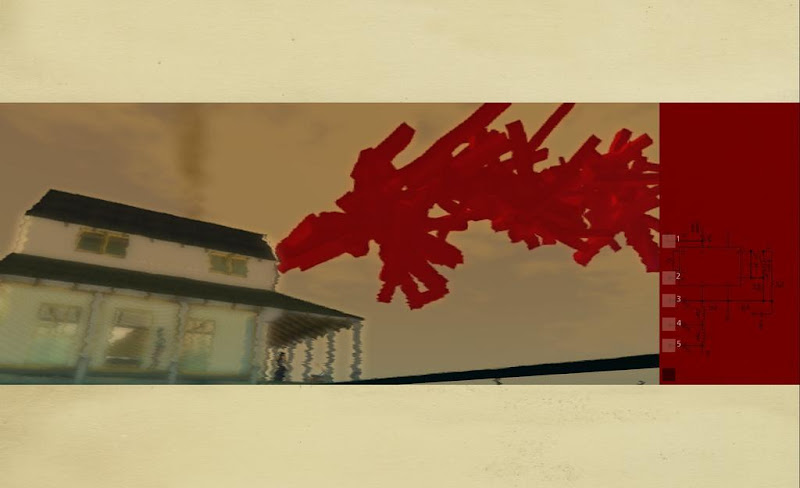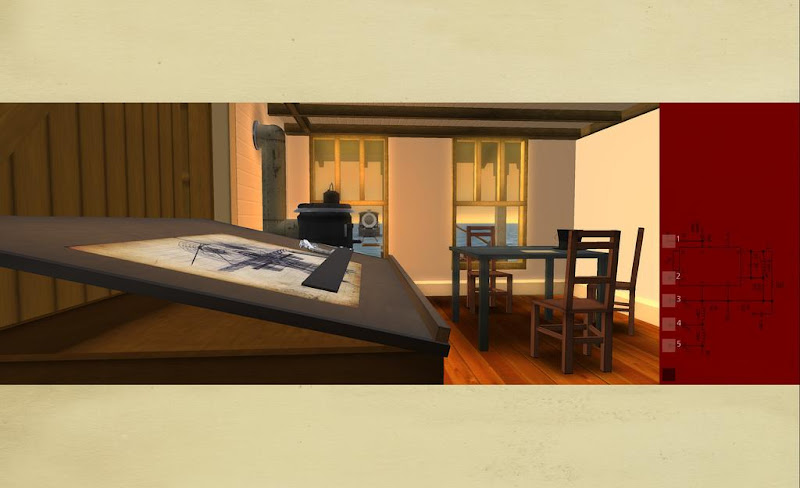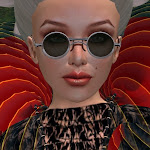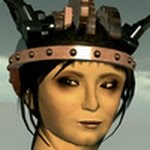Posted by Bettina Tizzy
Avatar AM Radio unveiled The Red and the Wild to the public yesterday. It is the first such art installation at the Institute for Digital Intermedia Arts, a hybrid art and design studio at Ball State University funded by the Lilly Endowment. AM is a narrative artist who uses prims, Second Life®’s basic in-world creation tools, to paint moody settings that are awash in nostalgia for a time when objects of wood and metal were shaped and crafted in a workshop or barn, and not in some faraway factory in Taiwan. A keen observer of nature, his Plein Air scenes are hyper-real, and always unmistakably American… the wheat fields of Illinois near his current home, and the vast expanses of the Northeast. Those who know, however, realize that there are surreal secrets and surprises tucked away in every AM Radio build.
...
It seems like forever ago; it seems like only yesterday. Matthew Kiddomen, then a member of our working group (NPIRL) and someone who left the grid for good soon after, sent me an IM some 20 months ago inviting me to come at once. “You must see this. It’s incredible,” he said.
I Set a Stack of Books by AM Radio
It was up in the sky above the IBM sandbox… a wheat field, an old rusty train, a table set with an odd assortment of objects including a violin, some grapes, and a sketch book. Also a quaint garage, an old fashioned gasoline pump, and a shadowbox recreation of Jacques-Louis David's painting The Death of Marat. There, too, was the creator of all this, a rather surprised but nevertheless congenial and very tall gentleman by the name of AM Radio, sporting a long black coat and top hat.
He had bits of straw about him and the air of a chimney sweep. Within five minutes there were many of us there. I recall that I teleported Pavig Lok and Orhalla Zander, among others. We peppered this man with questions and he answered them all quite obligingly. Yes, he’d created this about a year ago. Yes, it had been up in the sky all that time and no, he owned no land.
Today, even if you are only a minor explorer in Second Life, odds are good that you have ventured onto at least one installation created by AM Radio. You probably own a set of sticks that he has given you. Perhaps you also have one of his dragonflies.

So much has happened to you in the past couple of years.
AM Radio: Huge learning experience. Often people will see me and say, "Oh, you're a person." And I have gotten used to it, but AM Radio really sort of became a brand. People think it’s a bunch of people building. So I have learned a lot, you know, managing that. It really is a careful process. So there is the learning aspect, but really in the last couple years I think the most important thing, the most meaningful thing for me has been the idea that we can participate in these virtual world activities, and have a real impact on the real world… and sometimes it is only vaguely related. Showing up at a concert in Second Life, and someone in Africa gets a cow.
Not long after he rezzed The Far Away at Dreamworld, AM Radio began to sell plots of wheat to benefit Heifer International with 100% of the proceeds. Heifer is an organization that works to end hunger and poverty by providing livestock and environmentally sound agricultural training to improve the lives of people who struggle daily for dependable sources of food and income. It is best known for allowing people to "purchase" cows ($500US a piece) and other livestock. Today and just 20 months later, the sales of AM’s wheat have raised enough to buy a REAL herd of cows: $7,300 or nearly 15 cows.
Is there any way to know how your fundraising efforts have specifically benefited anyone?
AM Radio: Not specifically, not like the Adopt-a-Child programs you see on late night television. We like the cow metaphor Heifer uses. You know that $500 US is equal to a cow, or $120 a goat, but even then it’s impossible to say. Even if you knew you bought an actual cow because that cow’s milk is bought by other people in that town, trade occurs and neighbors converse, enemies begin to see advantages to understanding their neighbor. It's exponential.
Saturday was World Malaria Day. I recall that you did some fundraising for nets. Have you continued that effort?
AM Radio: Nothingbutnets.net - In 2008 I sold an off-road vehicle and the Lindens from those sales went to Nothingbutnets. That's a great program. Literally one net potentially saves one, or even two lives. For just $10 USD? I mean… come on, how better to spend ten bucks? Two Big Mac meals, or a teenager in Africa has anti-malaria nets at night to sleep in.
Is that vehicle still for sale?
AM Radio: That vehicle is not. You know, that was another thing I learned. Growth can be unpredictable. I had a very kind sim owner offer three sims, plus Princeton, and NMC and everything got complex really quickly, so I went back to my roots with the charity work, focusing on Heifer.
AM Radio: Yes, exactly. Splitting off was requiring management at levels I am not ready for yet. I need help!
He went on to create The Quiet for Princeton University and Husk for the New Media Consortium (NMC). Then came The Refuge and the Expansion for just one week, a sim-wide version of the wheat field, and today that same installation is three sims large, under the patronage of art collector Alexandar Vargas. Since then, AM has conjured two other acclaimed sims: Beneath the Tree that Died for the University of Kentucky and Waiting for You.
If people wanted to help you, what could they do?
AM Radio: Right now, the easiest thing to do is get the word out. Often people apologize to me, especially at music events hosted on the sims. They say, sorry, “I can't donate right now.” And I totally hear that. But one of the great things about Second Life is that participation alone adds to the momentum. Showing up and being excited inspires those who do have the ability to donate.
How has your view of art in a virtual scenario changed in the past two years?
AM Radio: That Virtual Worlds is a valid art medium. It went from “Oh, this is neat.” To, “Wow, something is happening here,” to “Wow, it's in the New York Times.”
Is this a confirmation? Or did you believe it was less than that before? And how about how you approach your art? Has that changed in any way?
AM Radio: I don't think I thought any less of the medium. I think I paused more on the perception of Second Life by its own users and the Real Life public, and yes, (it) absolutely changed my art process. I think in my Real Life art, I have always been drawn to organic subjects. The fields, the trees, but there was a frustration, having been born in the mid-seventies, and really growing up in a very plasticized and prepackaged, processed world... sunlight, for our generation, is something seen through Plexiglass windows, and my art is a reaction against that. It's looking for more… for the organic. So it was an attempt to tear down the fakery, all that plastic in impossible colors, and awful rugs, and terrible media, like television, but in Second Life, there's almost an acceptance that much of this generation has already been living virtual. Everything is controlled, and marketed, from the music to food, to the computers the cool kids use. And now, here I am in a virtual world, trying to create the organic. I think it is still a search, but almost feels like…(pause) …a responsibility.


I can't help but think... you and I both spend so much time in world. How has all this changed your own sense of place? The ability to create your own environment and live in it, and share it?
AM Radio: Let me be careful how I answer that. I don't want to dissuade criticism of my work... but my work is deeply personal. What you see is so much a part of me; these are symbols of my life and events, and my emotions. Yates said “Tread softly because you tread on my dreams...” My sense of space here, I suppose, has become a more elastic version of real life. You know I can place out what I want and I can share things, but people can visit and bring their own emotional baggage, and see what they want, and expand my own understanding of my own memories. It's like having hundreds of people analyzing your dreams and posting their thoughts about them on Flickr... thousands of them.
You mean... that they can affect your own understanding of your creations?
AM Radio: Yes. Some artists…
…prefer not to read the reviews of their works, for whatever reasons. I take it this is not the case with you. How much of what you read/hear/discuss about your work are you absorbing? Is it malleable? Vulnerable?
AM Radio: I think I try to read as much as I can. I think I often do go off on tangents on builds, and I sometimes forget about the bigger picture and mission of Second Life. It's easy when you have access to a sim to just cover the sky when Windlight isn't really jiving with what I am trying to do, but I still find myself challenged by this specific limitation to not be able to easily share settings. What I did was try to make a build that allowed you to easily remove my tinting. You can lower your draw distance a bit and return to the default sky, for example, and also it is a tinting, so the Windlight bleeds through, allowing for the user to work with their list of presets in ways they haven't seen them work before.

sensations by Thea Denja - Taken at "The Red and the Wild"
Your works, all of them, seem to hearken to days - we can only speculate - of your childhood. What we do know is that most people don't live like that anymore. The train that was rusty in The Far Away is new and more of a concept at The Red and the Wild. Are we entering a new era?
AM Radio: Maybe more toy-like at The Red and The Wild. The new sim is inspired by elements of my boyhood. The house itself figured centrally in my life. The other houses I have built were more abstract memories of houses. This one is nearly accurate. In fact, it is odd to see people walking on its porch and not feel like they're trespassing somehow.

AM Radio's train at The Red and the Wild
What age were you?
AM Radio: Oh, I must have been about ten.
Does the red abstract burst have a name? Care to explain it?
AM Radio: The sim has the same name (The Red and the Wild). I had been fooling with prims in an abstract way. I had started doing that way back; you might remember the boxes on The Far Away: The Way the Air moves.

The Way the Air Moves, by AM Radio
I think abstraction fails in a vacuum. I think an abstract painting looks far more interesting when a lady wearing a Packers jacket is fumbling through a museum looking at them, wondering if she should know more.

The Speckles in Your Iris, by AM Radio
AM Radio: There is a dialog between the abstract and the real that occurs in any abstract art, and I have had a really difficult time accepting abstract art in virtual worlds because that dialog is often missing. I think (that dialog... that ether for a relationship) most often works when the artist interrupts the abstraction with some inclusion of the avatar... with most avatars based on a very real human form. So, I have been really leery about using Abstraction in Second Life. I use it a lot in Real Life in my collage work. You can find some of those real life works on the new sim.
In fact, in the movie, Holly has created an entire virtual world for herself. Her escape is the commoditized world where money defines what's real, and I thought “Wow, this is really relevant to virtual worlds.” Later in the movie and in the novella, Holly says... "But you can't give your heart to a wild thing: the more you do, the stronger they get. Until they're strong enough to run into the woods. Or fly into a tree. Then the sky. That's how you'll end up, Mr. Bell. If you let yourself love a wild thing. You'll just end up looking at the sky," and suddenly my thoughts on injecting abstract shapes made sense.
I had the courage to say that this abstraction means something, that here is a symbol of something, that we have these abstract parts of ourselves, these fears, these wild things we try to bury, and without them, we don't become who we are. The Red and the Wild really is a comment on that relationship that abstraction and realism are not mutually exclusive. In fact, they rely on one another to even exist. In the end Holly, of course, realizes she's living in a self constructed world, and immediately begins to redefine it.













6 comments:
This is one of the best, and most insightful, interviews I have ever read on NPIRL.
I think 'The Red and The Wild' is my favorite of AM's builds thus far, and I loved what he had to say about the imagery and emotion that went into it.
I always love hearing (or in this case, reading) other artists discuss their work.
It means a lot to me that *you* have this opinion of the post, Neb. Thank you.
Interviewing AM is like plucking low-hanging fruit. It just comes naturally to him... no matter which path you lead him down.
After I posted this, I learned that it was AM's rez day! His third. Kicking myself for not checking that earlier. Happy Rez Day, AM! May there be many more.
My pleasure, Bettina! I'm flattered that you think highly of my opinion.
AM's introspection really is profound; I'm glad he's willing to share that part of his inner self. I can identify with that kind of soul-searching on many levels, so his work speaks to me as another artist, not only as a viewer.
How fitting that this post coincides with AM's third rezday! Awesome.
I already posted this comment last night in reply to yours on the Flickr group for AM's new build..The Red and The Wild.. but thought it might more appropriately fit here with your great interview, which I enjoyed rereading again today.
I have always enjoyed reading AM's responses to questions in interviews, or listening to him answer them, like in the radio interview on Arthole Radio, because rather than a flip, or rote answer to questions, he seems to really take his time to answer an interviewer's questions with seriousness, and a keen intelligence, and thoughtfulness.
He shows a very admirable openness to share with others, in a most articulate manner, things that have great meaning for him, and by doing so we gain some insight into what is behind the things he creates which only enriches the whole interaction. That emotional aspect about him, and his willingness to share some of that, is also apparent in all his builds.
I believe that is why, what he creates in SL has so much resonance for people who visit his builds, not to mention the great admiration we all have for him for his generosity to so many, and the wonderful work he does raising money for Heifer International in SL, which then has a most definite and positive outcome in the real world.
Really wonderful interview, Bettina, and really nice too with all the accompanying pictures.
Thank you for the excellent post. And thanks to AM Radio for his amazing work and willingness to share with the world.
First, excuse my poor english as i am french. I hope my words can convey what i feel after reading this article and visiting some AM Radio Installations.
I discovered his worlds yesterday and was profoundly moved by the emotional feeling and insight i witness in his creations. I am still a newbie (not 30 days old) and as an artist in life (writer and actress)i started building the first day i was in. This is to me the most compelling : the ability to create a visual environment where people can interact with freedom and emotions, to connect with their inner truth.
AM Radio is not only extraordinary inspired, but he seems to have the gift of being able to share and offer his visions to others so they can make them "their own" by triggering some of their own secret or hidden thoughts, bringing it to consciousness. This is a real gift. And a real mark of great talent.
Thank you for the inspiration.
- Daallinii
Post a Comment